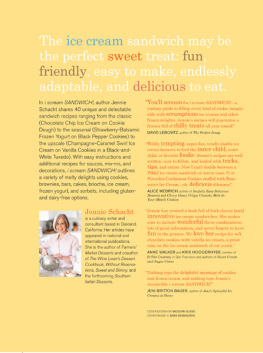To my boys; Chris for being my ultimate taste-tester, and Henry for sitting diligently by my side during this book's creation and not getting even one lick. The last recipe is for you, Henry.
Acknowledgments
There are lots of special people who helped make the dream of a Frostings book come alive! A huge thank-you to Kyle Dreier and Caroline Brewer for turning my recipes into artwork. You're a dream team. Thank you to Tessa Huff for helping me put the "icing on the cake" and your excitement over this project. Thank you to Jill Rigsby for diligently taste-testing frostings for hours on end and being a mixing-bowl-washing queen. Thank you to my husband for allowing our house to look like a frosting war zone for several months. Thank you to my brother, David, for his assistance in helping me with the culinary details of many of these frostings. Thank you to Jennifer Baumann for giving a web presence to my books. Thank you also to Hilari Schaefer, Alison Oliver, Mollie Jannasch, Rory White, and Ian Riley for your roles in making this book a realty. Thank you to Hollie Keith, Suzanne Taylor, Dan Moench, Kim Eddy, and the Gibbs Smith team for another wonderful project.
As always, thank you to the enthusiastic readers of Pizzazzerie.com who continue to inspire me to create and entertain in style! You are the reason I get to do what I love every day.
Introduction
There are two kinds of people in this world. Youre either a frosting person or a cake person. You can probably imagine which one I am. I was the little girl that ate the cake in my birthday cake slice first so that the delicious frosting was left last, and I could savor each bite of sugary sweetness. Im still that little girl. Its obvious what type of person this book is for. I like to think that frosting people are the creative ones, the thrill-seekers, the ones that appreciate the art of a perfectly tied bow and perfectly decorated party, the ones that love the icing on the cake! This book is for you! Dig in...
A little history lesson...
The first icings were created in the mid-seventeenth century and consisted of boiled sugar, egg whites, and flavorings like rose water. It was a pourable icing that produced a thick, glossy covering over cakes. In the mid-nineteenth century, frostings as we know them were developed. The Cassells New Universal Cookery Book (London, 1894) contained the first mention of cake made with flour and sugar rather than yeast. Shortly after that, buttercream recipes began replacing boiled sugar frostings.
Most American palettes prefer a buttercream frosting similar to what they grew up enjoying on birthday cakes. Its an easy frosting to decorate and cover cakes, cupcakes, and other treats. This book contains my favorite buttercream recipes as well as recipes for other types of frostings or icings such as glazes, ganaches, and boiled sugar frostings.
My hope is that you will discover your new favorite frosting but also enjoy experimenting with new flavor combinations. Frostings are similar to ice cream; you can flavor them and add mix-ins to enhance flavor and color. Many of these frosting flavor varieties were inspired by favorite ice cream flavors. I encourage you to mix and match your favorite flavors, colors, and candies to create your perfect frosting. As for mine? Well you can find it
Tips & Techniques
Equipment
The fundamental piece of equipment for frostings is an electric mixer. You can use either a standing electric mixer (paddle and whisk attachments) or an electric hand-mixer.
Candy thermometer
Double broiler (a heat-safe bowl over a saucepan of water can be substituted)
Pastry bags and piping tips
Food coloring gel
Flavorings and extracts
Spatulas and scrapers
Whisk
* See resources in back for recommendations on where to buy the items above.
Butter & Shortening
Butter and shortening are often exchanged for each other in frosting recipes. Butter is roughly 80 percent fat while shortening is 100 percent fat. Shortening in a frosting will produce a fluffier frosting that easily holds its shape for piped decorations. Frosting made with butter will have a slight yellowish tint. You can use 50 percent butter and 50 percent shortening or other combinations of fats in your recipes.
For a richer flavor, I recommend using unsalted grade A butter at room temperature. Try to use the highest-quality butter possible when making frostings. It is best not to soften butter in the microwave as it will begin to melt. All recipes in this book should use room temperature butter unless otherwise noted. To bring butter to room temperature, set it on a counter for at least 25 minutes.
Unsalted butter is recommended because it allows you more control over flavor because you can add salt in small amounts to your frostings.
Chocolate
Always use the highest-quality chocolate you can buy to provide a richer taste in your frostings. Use the chart below for assistance with types of chocolate. You can often find high-quality chocolate in the candy aisle in bar form. This can be chopped (or grated on top!) for use in these frosting recipes.
| Unsweetened chocolate 100% cocoa |
| Bittersweet chocolate 6580% cocoa |
| Semisweet chocolate 3550% cocoa |
| Dark chocolate Contains no milk, at least 35% cocoa |
| Milk chocolate at least 12% milk, usually 3345% cocoa |
| White chocolate not actually chocolate, contains 0% cocoa but instead consists of sugar, milk, and 20% cacao butter |
Powdered Sugar
Always sift your powdered sugar prior to use (especially in glazes!) to avoid clumps. Powdered sugar is also called confectioners sugar.
Extracts
Natural extracts are made with a variety of special oils and alcohol. You can find them in the grocery store (spice or baking aisle). They are used to enhance flavors of baked goods and, of course, frostings! You can find a variety of unusual flavor extracts online (see resources in back). It is best to start with a small amount of extracts (1/4 teaspoon) and increase by taste.
Piping Bags
You will find frosting decorating bags in three varieties: featherweight, disposable bags, and parchment triangles. Featherweight bags are reusable and made of coated polyester. Disposable bags are a clear triangular bag that comes in a variety of sizes. Parchment triangles are another common disposable bag for piping. For a makeshift piping bag, snip the corner of a plastic bag.
Frosting Tips
Thicker frosting recipes will produce a prettier piped decoration out of a frosting tip. You can always add more powdered sugar to a frosting to thicken it. A rule of thumb is that a knife sliced through the frosting should hold its indention shape for a frosting that is perfect for piping. If it molds back together, it is too loose for piping.










